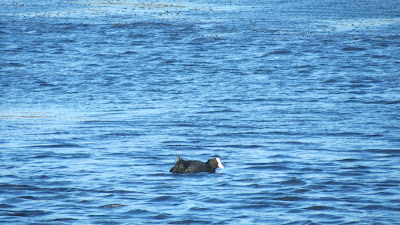For the last day of my 'Species Spotlight Challenge' I have chosen a very distinctive-looking duck, which is surprisingly common in the UK, considering that there is a good chance that, unless you are a birdwatcher, you have never seen one or perhaps even heard of the species. It is the Northern Shoveler (Spatula clypeata). As you will see from the first photo below (which is a free to use image from the internet because I couldn't get a picture of a male in its 'normal' plumage today- read on to find out why that is) the male shoveler, for most of the year, is a handsome duck (a bit smaller than a Mallard) with an irridescent green head, mostly white underparts except for the deep rusty-red patch on the side, and darker upperparts. Oh, and it has an enormous, weird-looking, flattened bill, which is where both the English name 'Shoveler' and the scientific name for the genus (Spatula) come from.
The bill is specially adapted (with small comb-like 'lamellae' on its edges) to filter food out of the water as the bird swings its head from side to side just below the surface. They breed in open wetlands and marshes with shallow muddy pools (which contain lots of the invertebrates and plants on which they feed). Shovelers are quite widespread as a breeding bird in the UK, with their core areas being the North Kent marshes, the Ouse Washes in East Anglia and the wetlands around the Humber estuary. The population is swelled, and their distribution expanded, in the winter, when our breeding birds are joined by those from other parts of Europe. This is when you are much more likely to see them - even in the middle of London where they can be observed at the London Wetland Centre (owned and managed by the Wildfowl and Wetlands Trust) in Barnes, a short bus ride from Hammersmith Tube Station. They can also be found in large numbers at reservoirs such as Abberton in Essex and Rutland Water in the Midlands.
Female Shovelers and 'eclipse' males (I'll explain this term in a minute) would look quite like a female Mallard (i.e. streaky brown) if it wasn't for the whopping 'schnozz' of a bill.
 |
A male shoveler in full breeding plumage
https://pixabay.com/photos/northern-shoveler-duck-plumage-5469305/ |
Eclipse Plumage
Ducks are unusual among birds in that they moult all their flight feathers at the same time (just after breeding, in late summer) and so become flightless for about a month or so. This makes them more vulnerable to predators and so the brightly coloured males of many species, including the familiar Mallard and today's spotlight species the Shoveler, have a different plumage at this time of year which makes them look more like the females and so less vulnerable to being caught and eaten. It also explains why I couldn't get a nice picture of a male in its typical plumage when I went out to Portrack Marsh today.
There are usually subtle differences which the experienced eye can use to tell which are females and which are eclipse males. In the case of Shovelers these males generally have darker heads, more rufous underparts and they retain a sky-blue patch on the wing (normally only visible in flight). In the photos below, I think the first one shows a female and the other two (the same bird in different postures) are of a male.
 |
Female Shoveler at Portrack Marsh, Teesside (5th Sept 2020)
|
 |
Eclipse male Shoveler at Portrack Marsh, Teesside (5th Sept 2020) - hiding
his distinctive bill but showing him using it to capture small food items |
 |
The same male Shoveler with a winter-plumage Black-headed Gull
|























